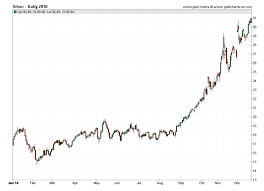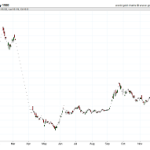The year 2010 marked a significant period for silver prices, with the metal experiencing wide fluctuations and setting record highs. Investors were faced with a volatile market, as silver prices ranged from $17.88 oz to a record high of $30.70 oz.
This article delves into the historical data, controversies, and speculations surrounding the fluctuations, records, and allegations surrounding silver prices in 2010.
Market information shows that allegations arose that JP Morgan inherited Bear Sterns’ losing COMEX silver naked short position in 2008. This led to speculation that JP Morgan had significant influence over the silver market, as the bank became a dominant player in the silver futures market.
Additionally, RT’s Max Keiser encouraged silver bullion stackers to buy and hold silver for the long term, leading to increased demand for physical silver.
Against this backdrop, SD Bullion offers historical and current silver price charts to provide investors with daily silver price data from 1968 to 2021. However, viewers are advised against using the information for speculative purposes, as SD Bullion does not guarantee the accuracy or completeness of the price data displayed.
Market Information
The website SD Bullion is a valuable resource for those interested in tracking fluctuations in silver prices in 2010. It offers a wealth of information on historical and current silver price charts, LBMA silver price auction information, and forex silver market prices. This comprehensive market information can be used to develop trading strategies and stay abreast of global market trends in the precious metals industry.
The forex silver markets trade continuously 24 hours a day from Sunday evening 6:00 PM (Eastern Time) to Friday 5:00 PM (Eastern Time), making it a valuable source of real-time market data. Additionally, the LBMA silver price auction starts at noon London time, providing a benchmark for silver prices worldwide.
It is important to note that using this information for speculative purposes is not advised and that SD Bullion does not guarantee the accuracy, timelines, or completeness of price data displayed on the website.
Historical Data
Utilizing the historical data available on SD Bullion’s website is like peering through a window into the past, providing an objective snapshot of the silver market during the year of 2010.
From January to December, the silver market experienced fluctuations in price, with the highest price of $30.70 oz reached on December 30, 2010, and the lowest price of $17.88 oz recorded on August 24, 2010.
Throughout the year, silver prices were influenced by various factors, including market speculation, global economic conditions, and allegations of market manipulation.
Long-term trends can be observed from the historical data, with silver experiencing a steady increase in price from August to December 2010.
Additionally, the allegations of market manipulation by JP Morgan inherited from Bear Sterns’ losing COMEX silver naked short position in 2008 may have influenced the price of silver during this period.
Price analysis of the historical data provides valuable insights into the silver market, allowing investors to make informed decisions based on past trends and market conditions.
Controversies and Speculations
An examination of the historical data available on SD Bullion’s website reveals several controversies and speculations that may have impacted the silver market in 2010.
One of the most notable controversies involved JP Morgan’s alleged inheritance of Bear Stern’s losing COMEX silver naked short position in 2008. Many analysts have speculated that JP Morgan’s large position in the silver market may have contributed to the price fluctuations observed during 2010. While there is no concrete evidence supporting these allegations, they remain a topic of interest among silver investors.
Another notable figure in the silver market during this time was Max Keiser, who encouraged silver bullion stackers to buy and hold silver for the long term. His advice was based on the belief that the value of paper currencies would continue to decline, making precious metals an attractive investment. While Keiser’s advice may have contributed to increased demand for silver, it is difficult to determine the extent to which it influenced prices during 2010.
Nonetheless, the controversies and speculations surrounding JP Morgan’s position and Max Keiser’s advice highlight the complex and often opaque nature of the precious metals market.
Frequently Asked Questions
What factors influenced the fluctuations in silver prices in 2010?
The fluctuations in silver prices in 2010 were influenced by a combination of investor behavior and mining production. Factors such as economic uncertainty, geopolitical tensions, and inflationary concerns also played a role in shaping market sentiment.
How did the global economic climate impact silver prices in 2010?
Global supply and investment demand were significant factors impacting silver prices in 2010. The global economic climate, including the European debt crisis, influenced investor sentiment and demand for safe-haven assets, driving up silver prices.
What were the most significant events or news stories that affected silver prices in 2010?
Alleged manipulation and investor sentiment were significant factors affecting silver prices in 2010. The allegations of JP Morgan inheriting Bear Sterns’ losing COMEX silver naked short position sparked investor concern, while RT’s Max Keiser encouraged long-term silver bullion stacking.
How do silver prices in 2010 compare to previous years?
Comparative analysis of historical trends shows that silver prices in 2010 were higher than the previous year, with a range of $17.88 to $30.70 per ounce. Prices fluctuated throughout the year due to various market factors.
What is the outlook for silver prices in the future based on trends from 2010?
Based on industry demand and silver investment trends in 2010, future outlooks for silver prices may be positive. With the potential for increased demand in various industries, silver may continue to be a viable investment option.





